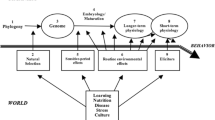Abstract
Reductionist explanations in biology generally assume that biological mechanisms are highly deterministic and basically similar between individuals. A contrasting view has emerged recently that takes into account the degeneracy of biological processes—the ability to arrive at a given endpoint by a variety of available paths, even within the same individual. This perspective casts significant doubt on the prospects for the ability to predict behavior accurately based on brain imaging or genotyping, and on the ability of neuroscience to stipulate ethics.

Similar content being viewed by others
References
Bell, W. J. (1990). Searching behavior. New York: Chapman and Hall.
Bellone, E. (1980). A world on paper: Studies on the second scientific revolution. Cambridge: MIT Press.
Berg, H. C. (1983). Random walks in biology. Princeton, NJ: Princeton University Press.
Briggman, K. L., Abarbanel, H. D., & Kristan, W. B. (2006). From crawling to cognition, analyzing the dynamical interactions among populations of neurons. Current Opinion in Neurobiology, 16, 135–144.
Chen, R., Cohen, L. G., & Hallett, M. (2002). Nervous system reorganization following injury. Neuroscience, 111, 761–773.
Churchland, P. S. (2011). Brain trust. Princeton, NJ: Princeton U. Press.
Dewey, J. (1910). The influence of Darwin on philosophy. In J. Dewey (Ed.), The influence of Darwin on philosophy and other essays. New York: H. Holt & Co.
Dierick, H. A., & Greenspan, R. J. (2006). Molecular analysis of flies selected for aggressive behavior. Nature Genetics, 38, 1023–1031.
Edelman, G. M. (1987). Neural Darwinism. New York: Basic Books.
Edelman, G. M., & Gally, J. (2001). Degeneracy and complexity in biological systems. Proceedings of the National Academy of Sciences USA, 98, 13763–13768.
Fox, M. D., & Raichle, M. E. (2007). Spontaneous fluctuations in brain activity observed with functional magnetic resonance imaging. Nature Reviews Neuroscience, 8, 700–711.
Georgopoulos, A. P. (1994). Population activity in the control of movement. International Review of Neurobiology, 37, 103–119.
Gould, S. J., & Lewontin, R. C. (1979). The spandrels of San Marco and the Panglossian paradigm, a critique of the adaptationist programme. Proceedings of the Royal Society of London Series B, 205, 581–598.
Greenspan, R. J. (2001a). The flexible genome. Nature Reviews Genetics, 2, 383–387.
Greenspan, R. J. (2001b). History, biology and individuality. Nimrod, 45, 141–151.
Greenspan, R. J. (2009). Selection, gene interaction, and flexible gene networks. Cold Spring Harbor Symposium on Quantitative Biology, 74, 131–138.
Hartman, J. L., IV, Garvik, B., & Hartwell, L. (2001). Principles for the buffering of genetic variation. Science, 291, 1001–1004.
Heisenberg, M. (1994). Voluntariness (Willkurfahigkeit) and the general organization of behavior. In R. J. Greenspan & C. P. Kyriacou (Eds.), Flexibility and constraint in behavioral systems (pp. 147–156). New York: Wiley.
Hirsch, J. (1963). Behavior genetics and individuality understood. Science, 142, 1436–1442.
Nowak, M. A., Boerlijst, M. C., Cooke, J., & Smith, J. M. (1997). Evolution of genetic redundancy. Nature, 388, 167–171.
Pinker, S. (1997). How the mind works. New York: W.W. Norton Inc.
Srinivasan, R., Russell, D. P., Edelman, G. M., & Tononi, G. (1999). Increased synchronization of neuromagnetic responses during conscious perception. Journal of Neuroscience, 19, 5435–5448.
Toma, D. P., White, K. P., Hirsch, J., & Greenspan, R. J. (2002). Identification of genes involved in Drosophila melanogaster geotaxis, a complex behavioral trait. Nature Genetics, 31, 349–353.
Tononi, G., Edelman, G. M., & Sporns, O. (1998). Complexity and coherency, integrating information in the brain. Trends in Cognitive Science, 2, 474–484.
Wu, J. Y., Tsau, Y., Hopp, H. P., Cohen, L. B., Tang, A. C., & Falk, C. X. (1994). Consistency in nervous systems, trial-to-trial and animal-to-animal variations in the responses to repeated applications of a sensory stimulus in Aplysia. Journal of Neuroscience, 14, 1366–1384.
Author information
Authors and Affiliations
Corresponding author
Rights and permissions
About this article
Cite this article
Greenspan, R.J. Biological Indeterminacy. Sci Eng Ethics 18, 447–452 (2012). https://doi.org/10.1007/s11948-012-9379-2
Received:
Accepted:
Published:
Issue Date:
DOI: https://doi.org/10.1007/s11948-012-9379-2




